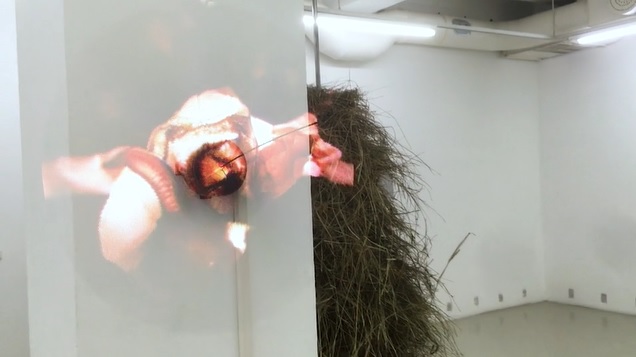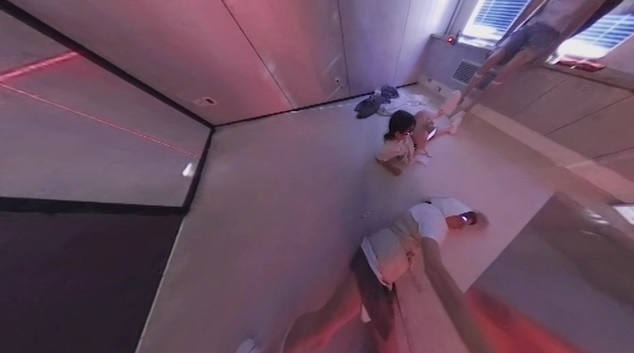Artists: Dorota Gawęda & Eglė Kulbokaitė
Title: RYXPER1126AE
Venue: Trafó Gallery, Budapest
Text: Ella Plevin
‘This enclosed container houses something we cannot perceive, a memory to the past or an illusion. It is enclosed here in its image and its form, flattened akin to a 19th century diorama. A camera establishes the way of seeing without permission to full understanding without permission to be inhaled.’

Entrance and Exit is usually marked by the sound of a sharp intake of breath. Rasping crucible for a succession of lurid events. Dyads are responsive: if you breathe in short and sharp, it’s likely your hrátsi will be the same. But if you breathe a steadier, deeper breath, the hrátsi (hrátsi is a neologism coined by Ella Plevin from the conjunction of the Czech hrát si –
meaning playing with yourself / playing alone / playing within) tend to last longer and offer more varied paths. Some say this makes one better equipped to deal with loose mals upon such paths too.
Your body (your Honmoro body) seems to suck it down involuntarily as most usual, but that’s just the hsware-bio countermand or disengagement protocols. That sensation of air in the throat is as synthetic as the ribs that make its bellows, but the transition isn’t too bad. Sometimes there’s a pleasing prickle of warmth on the neck, like iron filings being stripped from your medulla in some magnetic kiss. Your head unhairs. All beamy. Jumping apostles. Syrup.
Dyads began as a scalable high-bandwidth BMI system with individually networked spores introduced to preserve and enhance the brain and “ultimately achieve a sort of symbiosis with artificial intelligence”, which is what they called it then lol. It was a retro array-style interface of small and flexible trode threads, many thousands of electrodes distributed across 96, 108 and then eventually 777 threads which were inserted into the cranium by early neurosurgical robota with micronprecision capability.
There were problems at first. Channels were hacked and broadcast, much to everyone’s initial delight. But on learning to read one another’s thoughts we came to regret it. Everyone was invariably psychoti. Ravaged by Nasilya Kartina, purulent with egregores. Battlements along the mind’s frontier had been built organically out of language, in order that each of us might cower from that unknown known that everyone else was at least as deranged, if not further out. Ourself behind ourself, concealed. Laws were passed and protective measures were taken.
Now, you can really hide in a language. Let it slip around all that you do like a net. But languages aren’t only made up of words and letters – there is vernacular of smells and skins to these composite parts too. Some are made of piles of stone, or soft down or light. Others dissolve in your mouth: a cave of ash. When you name the things around you, you drown them. Your understanding of this is like the water in the tank: if you want to live as a fish it will keep you alive. If you realise you are not a fish your lungs will burn with it and you are the one who drowns and dissolves.
This is why we built the BEAL/BAL (Balsamic Encephalatic-Assimilate Landscape) systems network, an early imaging system to map the confluence of experience, understanding and sentiment that make up a personage and blend it into a terraformed language scape known as one’s Ātrena. It feels less confrontational as an immersive, haptic environment one can explore and maintain during each hrátsi.
So, I breathed in. The fog door rose around the hráčina (me) and I waited for it to settle into the endless forms of seemingly chaotic, incessant improvisation. The architecture created is a blend of digital spolia from the archive of my own and dear one’s interfaces, and although it generates differently each time, there is a glottal quality to it, as if it were sung straight from us. The Chatres pilgrims had nothing on the “epiphany junky,” “wonder addict,” or “curator of awe” one becomes upon scaling
the peaks and depths of such spaces.
If one is to describe the inner landscapes it is always in terms such as this:
monkey-brown, fish-grey, a string of infected circles above unwholesome ground, perhaps the skin of a grave bearing adhesive betrayal. The limits of language are the limits of the world, so there is a naturally occurring adjustment to the ensconced personality in exchange for this view, including a certain amount of unusualities in perspective. But the sun of the mind rises a ribbon at a time too.
Mine usually springs from a short elliptical colonnade and a large charis paddockpopulated by spiked grass Salsabiils beneath a sign marked 791 in something like Persian script leading the way in. Further along winding paths a Columbarium of some guise marks a squalid catalog of mistakes, my library of poor choices and slights constrained in lead boxes to better restrain their odious contents. On their interment they became discoloured, first turning green, then purple, before black as parts bulge from sockets, and other wretched parts bloat, protrude and nally swell each form burstopen with foul-smelling gases.
It was best not to touch these. Further on, things which could not be buried or burned – such as ideas or hopes dashed short – are put into charnel ground and left out for amorphous blends of jackals and hyaenas, tigerbears, vultures and ravens. A land of total openness and freedom. Festoons of wet intestines hang low from the trees here, above beds of viper plants littered with the shards and nubs of femurs, patellas, tusks.
Mals blow through the hrátsi like weather. Sometimes they cluster and became a thick black bonerinse of a mist. But it’s always worst when they take the faces most beloved to hráči outside of one’s Dyad. Mothers and fathers, women once loved and children unborn but not forgotten. All can appear suddenly and tear you up to be spat back through the collonade.
Now, before I tell you what occurred on this particular instance I ought to mention that my honmoro face was once a bag of tics and grimaces and that I was described as “fragile, nervously” as a child before growing into a few years amounting to a six and a half foot scowl.
In this particular hrátsi the refracted gardens and glades a orded by the Dyad had possessed themselves to form a red brick labyrinth. There was the sense that this was some retired center of industry, once producing many parts of the Ātrena I knew well from other journeys, although now they appeared in plain forms I didn’t recognise, or as bare wireframes. The arrangement of the rooms seemed to shift too, but in each I caught the scent of rubbed grass or perhaps wet stone and the balm of many stranger’s fingers beneath the swing of a thurible. It lead me through to a dark vault. The stones here had a hallowed, whispered quality and although a
small lightwell seemed to bear the darkness up rather than beckon illumination inwards, some small omphalion shone low upon a wall. As I peered more closely at it I saw that same tall scowl leering up at me rendered in ashes and abstractions.
We stood there, primed to fight or embrace one another. The rendered man and hishungry ghost.
“Now everything’s all confused again, like it was before” he told me.
“But this confusion is you as I am, not as we’d like to be.”
I turned in a circle and breathed the deep breath in.
Dorota Gawęda and Eglė Kulbokaitė: SULK
The video SULK is composed of documentation material from the performance of YGRG159:SULK (2018), which took place at ANTI – Athens Biennale 6 and gave rise to RYXPER1126AE fragrance now on view at Trafo Gallery. YGRG159:SULK is a performance in six acts, contractual, ritual-like gestures carried out as part of the choreography, each of which contributed to the olfactory composition of RYXPER1126AE. Thinking through Foucauldian biopolitics as well as pharmacopornographic regime (Paul B. Preciado), we can no longer understand bodies as “finite unities” but instead fluid, porous cartographies or else distributed networks of corporate agency (Margarida Mendes).
The script of the performance includes appropriated excerpts of texts by Ursula K. Le Guin, Margarida Mendes, Elvia Wilk, Donna Haraway, Sara Ahmed, Rosi Braidotti, George Eliot, Maurice Merleau-Ponty, Sarah Sharma, Octavia Butler, Olga Tokarczuk, Leslie Jamison, Richard Sennett, Timothy Morton, Hito Steyerl, Martti Kalliala and others.

Performers: Hara Kiri, Belle Santos, Petros Touloudis
